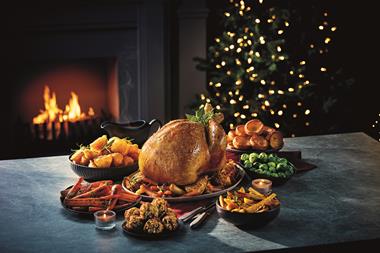The focus is back on the c-store sector in the battle for market share in grocery, with the multiples circling all sites on the market, says Michelle Perrett
The recession may have battered retailers, but grocery has emerged from the storm in pretty good shape with c-stores particularly resilient.
C-store sales grew 6.3% to £30.9bn in the past 12 months, according to the IGD Convenience Report. Yet store numbers in the sector were up just 0.2%, reveals the latest Grocery Retail Structure survey, compiled by IGD and William Reed Business Media, publisher of The Grocer. This would seem to disprove the theory that the space race is being most fiercely fought in the convenience sector.
But dig a little deeper into the data and a rather different picture emerges. On the face of it, the supermarket format is enjoying the strongest growth overall, with numbers up 3.2%. This figure, however, includes significant growth in the number of smaller stores (partly the result of the conversion of former Woolworths stores).
Much of the growth in store numbers for the top 10 multi-format retailers, meanwhile, is clearly being driven by their convenience formats, Tesco's 10.8% increase in total store numbers boosted by a 15% uplift in its c-store estate, and Sainsbury's 10.1% rise in overall numbers aided by a whopping 27.6% increase in c-stores.
Indeed, while the overall number of c-stores has been dragged down by a 5% slump in non-affiliated independents, this has been mitigated by sharp rises in numbers for other c-store operators notably symbol groups. Many independents have, in fact, joined symbol groups, sending their numbers soaring 7.8% and making symbols the fastest-growing convenience segment.
Tesco plans to open 181 Express and 32 One Stop stores by February 2011, Sainsbury's has opened 51 stores during 2009/10 and plans 75 more in 2010/11 and Waitrose is trialling smaller format stores. The Co-op Group also has major expansion plans and Asda has acquired Netto's UK estate, marking a concerted foray into smaller stores.
Renewed levels of interest in the c-store and smaller store formats and new interest from the likes of Waitrose and Asda can largely be attributed to their resilience during the recession, says Tony Evans, head of retail at Christie & Co. "The c-store market has been less susceptible to the downturn," he says. "People's shopping habits have changed and they are top-up shopping more often."
Jamie Trust, IGD senior business analyst and author of the convenience report, agrees. Population growth, an increase in single-person households and longer working hours have also boosted sales, to the point where c-stores now account for 20.9% of total spend in the UK grocery market, he adds. Prior to the recession, attention seemed to be moving away from smaller-format stores. Now they look set to become the focus of a major space race as the multiples take advantage of all the sites coming on to the market and the changing rental environment.
Despite concerns raised by Boots chief executive Andy Hornby last month that property costs will stifle expansion, Christie & Co believes the market has changed. "If you go back a year or so, a lot of people were trying to vary terms of rental payments and some were trying to renegotiate," Evans says. "But landlords have become more pragmatic."
Values across both freehold and leasehold have also come down. During 2009, values dropped by 9.8%, compared with a decline of 6.5% in 2008, according to Christie & Co. Since the peak of the market in the final quarter of 2007, retail property values have fallen 16%.
Appetite for acquisitions
Transactional activity hampered by the lack of available debt has hindered the plans of some operators, Evans admits, but the appetite for new site acquisitions is there. "Regional multiples and smaller convenience stores with 10 to 15 sites will look to acquire and will look for organic growth."
Closures of pubs and post offices are providing a strong pipeline of sites, with many in the centre of communities, often housing estates, and with little restriction on planning regulations. Other sites are targets for potential redevelopment for the larger chains, such as Tesco. There are also likely to be more opportunities to buy smaller chains in the wake of Asda's purchase of 193 smaller-format stores, mostly freehold, from Netto.
Trust highlights another opportunity. "One interesting area of development is new, less saturated locations with a growing demand for convenience, such as airports, rail stations, hospitals and motorway service stations."
Him! Research and Consulting director Tom Fender agrees the competition will be aggressive. "Actual store numbers will not see an increase but a change in the make-up of the sector," he argues. "They will be buying small chains, independent stores and high-street stores. Tesco has already bought 15 to 20 pubs, which can be transferred into Express stores."
Value for money
This year Tesco has increased its c-store sites by 15% and its supermarket estate by 5%, despite pressure from the Nimbys. The UK's largest supermarket holds a relatively small share of the c-store sector, at 5.7%, so the opportunity for expansion is huge. "Tesco's model means they can pay more for sites than other chains because of their return on investment," Fender adds.
The supermarket and superstore sector is also poised for further growth, driven by factors such as new store developments by major multiples and variety store operators in particular. 99p Stores has increased its estate by 50% and Poundland by 31.7%, fuelled by their acquisition of Woolworths sites and consumer desire for value for money.
Other formats are lagging behind in the great space race. The volatility of oil prices has put particular pressure on forecourt operators, though even with the drop in forecourt c-stores down 2.2% over the year sales increased by 1.9%.
"Despite the number of forecourt stores decreasing, last year was another in which the segment reinvented itself, with new and existing forecourt operators continuing to deliver operational improvements and a more sophisticated offer," says Trust. "Many leading players, including Texaco and Shell, modernised their brands and fascias. Investment will continue in 2010, with many chains rolling out refreshed brands."
Traditional retail has also fared badly as far as store numbers go, falling 1.4% last year, predominantly due to a decrease in specialist CTNs and off-licence outlets. The sharp decline in specialist off-licences (13.3%) was linked to the demise of First Quench Retailing last year, an operator of nearly 1,200 stores. Most have now closed, with the remaining stores still trading or sold off to other operators.
Looking ahead, the sectors with most potential for expansion are convenience and smaller stores. As the big four look to expand their portfolios, expect further consolidation and change. The next leg of the convenience space race is about to kick off.
Hot property
How the different formats' store numbers measured in the 12 months to April 2010:
C-stores: +0.2%
Supermarkets: +3.2%
Forecourt c-stores: -2.2%
Traditional retail: -1.4%
Total grocery retail: 0.4%
Grocery Retail Structure 2010
The recession may have battered retailers, but grocery has emerged from the storm in pretty good shape with c-stores particularly resilient.
C-store sales grew 6.3% to £30.9bn in the past 12 months, according to the IGD Convenience Report. Yet store numbers in the sector were up just 0.2%, reveals the latest Grocery Retail Structure survey, compiled by IGD and William Reed Business Media, publisher of The Grocer. This would seem to disprove the theory that the space race is being most fiercely fought in the convenience sector.
But dig a little deeper into the data and a rather different picture emerges. On the face of it, the supermarket format is enjoying the strongest growth overall, with numbers up 3.2%. This figure, however, includes significant growth in the number of smaller stores (partly the result of the conversion of former Woolworths stores).
Much of the growth in store numbers for the top 10 multi-format retailers, meanwhile, is clearly being driven by their convenience formats, Tesco's 10.8% increase in total store numbers boosted by a 15% uplift in its c-store estate, and Sainsbury's 10.1% rise in overall numbers aided by a whopping 27.6% increase in c-stores.
Indeed, while the overall number of c-stores has been dragged down by a 5% slump in non-affiliated independents, this has been mitigated by sharp rises in numbers for other c-store operators notably symbol groups. Many independents have, in fact, joined symbol groups, sending their numbers soaring 7.8% and making symbols the fastest-growing convenience segment.
Tesco plans to open 181 Express and 32 One Stop stores by February 2011, Sainsbury's has opened 51 stores during 2009/10 and plans 75 more in 2010/11 and Waitrose is trialling smaller format stores. The Co-op Group also has major expansion plans and Asda has acquired Netto's UK estate, marking a concerted foray into smaller stores.
Renewed levels of interest in the c-store and smaller store formats and new interest from the likes of Waitrose and Asda can largely be attributed to their resilience during the recession, says Tony Evans, head of retail at Christie & Co. "The c-store market has been less susceptible to the downturn," he says. "People's shopping habits have changed and they are top-up shopping more often."
Jamie Trust, IGD senior business analyst and author of the convenience report, agrees. Population growth, an increase in single-person households and longer working hours have also boosted sales, to the point where c-stores now account for 20.9% of total spend in the UK grocery market, he adds. Prior to the recession, attention seemed to be moving away from smaller-format stores. Now they look set to become the focus of a major space race as the multiples take advantage of all the sites coming on to the market and the changing rental environment.
Despite concerns raised by Boots chief executive Andy Hornby last month that property costs will stifle expansion, Christie & Co believes the market has changed. "If you go back a year or so, a lot of people were trying to vary terms of rental payments and some were trying to renegotiate," Evans says. "But landlords have become more pragmatic."
Values across both freehold and leasehold have also come down. During 2009, values dropped by 9.8%, compared with a decline of 6.5% in 2008, according to Christie & Co. Since the peak of the market in the final quarter of 2007, retail property values have fallen 16%.
Appetite for acquisitions
Transactional activity hampered by the lack of available debt has hindered the plans of some operators, Evans admits, but the appetite for new site acquisitions is there. "Regional multiples and smaller convenience stores with 10 to 15 sites will look to acquire and will look for organic growth."
Closures of pubs and post offices are providing a strong pipeline of sites, with many in the centre of communities, often housing estates, and with little restriction on planning regulations. Other sites are targets for potential redevelopment for the larger chains, such as Tesco. There are also likely to be more opportunities to buy smaller chains in the wake of Asda's purchase of 193 smaller-format stores, mostly freehold, from Netto.
Trust highlights another opportunity. "One interesting area of development is new, less saturated locations with a growing demand for convenience, such as airports, rail stations, hospitals and motorway service stations."
Him! Research and Consulting director Tom Fender agrees the competition will be aggressive. "Actual store numbers will not see an increase but a change in the make-up of the sector," he argues. "They will be buying small chains, independent stores and high-street stores. Tesco has already bought 15 to 20 pubs, which can be transferred into Express stores."
Value for money
This year Tesco has increased its c-store sites by 15% and its supermarket estate by 5%, despite pressure from the Nimbys. The UK's largest supermarket holds a relatively small share of the c-store sector, at 5.7%, so the opportunity for expansion is huge. "Tesco's model means they can pay more for sites than other chains because of their return on investment," Fender adds.
The supermarket and superstore sector is also poised for further growth, driven by factors such as new store developments by major multiples and variety store operators in particular. 99p Stores has increased its estate by 50% and Poundland by 31.7%, fuelled by their acquisition of Woolworths sites and consumer desire for value for money.
Other formats are lagging behind in the great space race. The volatility of oil prices has put particular pressure on forecourt operators, though even with the drop in forecourt c-stores down 2.2% over the year sales increased by 1.9%.
"Despite the number of forecourt stores decreasing, last year was another in which the segment reinvented itself, with new and existing forecourt operators continuing to deliver operational improvements and a more sophisticated offer," says Trust. "Many leading players, including Texaco and Shell, modernised their brands and fascias. Investment will continue in 2010, with many chains rolling out refreshed brands."
Traditional retail has also fared badly as far as store numbers go, falling 1.4% last year, predominantly due to a decrease in specialist CTNs and off-licence outlets. The sharp decline in specialist off-licences (13.3%) was linked to the demise of First Quench Retailing last year, an operator of nearly 1,200 stores. Most have now closed, with the remaining stores still trading or sold off to other operators.
Looking ahead, the sectors with most potential for expansion are convenience and smaller stores. As the big four look to expand their portfolios, expect further consolidation and change. The next leg of the convenience space race is about to kick off.
Hot property
How the different formats' store numbers measured in the 12 months to April 2010:
C-stores: +0.2%
Supermarkets: +3.2%
Forecourt c-stores: -2.2%
Traditional retail: -1.4%
Total grocery retail: 0.4%
Grocery Retail Structure 2010















No comments yet